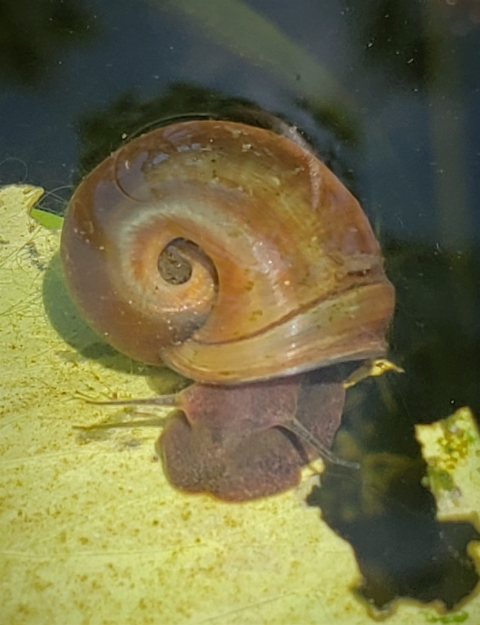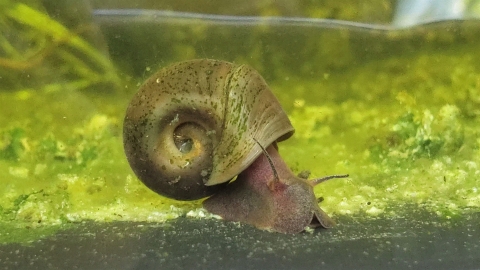Overview
The magnificent ramshorn snail (Planorbella magnifica) is an air-breathing freshwater gastropod mollusk. It is an integral part of a complex food web that was historically only from freshwater ponds in coastal North Carolina. This rare snail was last documented in the wild in 2004 and currently persists in captivity. It is presumed extirpated from the Lower Cape Fear River Basin. If enough habitat is secured in suitable ponds and sustained into the future, magnificent ramshorn snails could be released to repopulate their historical habitat.
In 2023, the magnificent ramshorn snail was listed as endangered under the Endangered Species Act.
Physical characteristics
Size and shape
The magnificent ramshorn is an aquatic pulmonate (i.e., air-breathing) gastropod mollusk. It has a coiled shell in the shape of a ram’s horn. Its brown coiled shell - often with leopard-like spots-grows to the size and weight of a U.S. dollar coin, just under 1.5 inches and less than 1 inch in height. The width of its shell, in relation to the diameter, makes it easily identifiable at all ages to those familiar with freshwater snails. It’s also distinctive in that its aperture is very large, bell-shaped, and is the widest section of the coil. It also loses its eyesight over time as the eyes become covered by the thickened cuticle.
Habitat
The snail is adapted to still or slow-flowing aquatic habitats, and lays eggs on spatterdock and lily pads. Salinity and pH appear to have been major factors limiting the distribution of the magnificent ramshorn, as the snail prefers freshwater bodies with pH within the range of 6.8–7.5.
Food
The magnificent ramshorn snail is an herbivore. It eats submerged aquatic plants, algae, and detritus. In captivity, one of their favorite food items is ripe seed head of spatterdock. They eat various other plants, including lettuce, and algae wafers with spirulina. Juveniles have been observed feeding on detritus and biofilm. Like other snails, it has a radula, sometimes called a “rasping tongue,” that scrapes against the substrate they are crawling across.
Current Range
Believed to be extirpated from the wild. The last individual seen in the wild was in 2004-2005.
Historical range
The magnificent ramshorn is believed to be found only in southeastern North Carolina. The species was historically known from only four sites in the lower Cape Fear River Basin in North Carolina — the snail appears to be extinct at all four sites.
Surveys of more than 100 potential sites over the last few decades have not uncovered any additional localities with this snail. Although the complete historical range of the species is unknown, its size and the fact that it was not reported until 1903 suggest that the species may have always been rare and localized.
Partnerships, Research and Projects
The U.S. Fish and Wildlife Service works with others to implement conservation. Three organizations maintain a captive population of the species to ensure its survival and produce individuals for future reintroductions. Known surviving individuals of the species are held and propagated by the following organizations:
- North Carolina Wildlife Resources Commission’s Marion Conservation Aquaculture Center currently has about 1,000 magnificent ramshorn snails in captivity.
- Coastal Plain Conservation Group (CPCG) has several hundred snail in captivity and provides ecosystem research, conservation education, and habitat management.
- North Carolina State University’s College of Veterinary Medicine and Department of Applied Ecology are holding several hundred snails and are studying increased production techniques to support reintroduction into the wild.
In captivity, the magnificent ramshorn snail is thriving by the thousands. Finding the high quality and salt-free habitat it needs is a priority to securing its future. A team of experts led by the North Carolina Wildlife Resources Commission is evaluating the reintroduction potential of several sites, including laboratory studies to define optimal water quality conditions for reintroduction sites.
The next step is recruiting private landowners in the Wilmington area who are willing to carry out conservation actions to benefit the snail. During the summer of 2018, Service biologists conducted field surveys to identify presence of spatterdock and lily pads, and evaluate general site conditions and pH levels.
Partners also began a new project in 2022 and are working together to evaluate the magnificent ramshorn’s genetic diversity and refine captive propagation techniques to support reintroduction into the wild.
How you can help
Landowners in a few areas within (or with similar characteristics to) the historic range can shore up dams that protect ponds, providing safe homes for the snails and other valued species, and preserving the scenic appeal of cypress trees and water lilies that share their need for freshwater. Finding enough suitable ponds for the magnificent ramshorn snails in the lower Cape Fear River basin is an urgent need.
Scientific Name
Identification Numbers
Timeline
Explore the information available for this taxon's timeline. You can select an event on the timeline to view more information, or cycle through the content available in the carousel below.
25 Items




